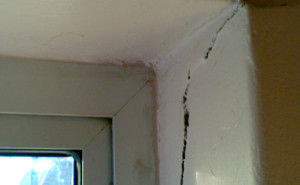 ByeMould is very pleased to present the following guest post from Right Surveyors. A common problem when buying houses is that many houses will have cracks in their walls. Should wall cracks be something to worry about, what is the best thing to do if you do see wall cracks? Well, thankfully Right Surveyors answer those questions below.
ByeMould is very pleased to present the following guest post from Right Surveyors. A common problem when buying houses is that many houses will have cracks in their walls. Should wall cracks be something to worry about, what is the best thing to do if you do see wall cracks? Well, thankfully Right Surveyors answer those questions below.
So picture the scene – you’re viewing a home which you want to buy, walking round with the estate agent. It seems perfect – large kitchen, period features, glorious master bedroom. But wait. There’s cracks in the exterior wall? Should you still buy it or should you pause and reconsider?
As surveyors, we see cracks in properties every day. Some shouldn’t worry you at all. Some can stop you getting a mortgage and leave you with hefty repair bills down the line. But which is which and what should you do?
Sound out the Estate Agent
Firstly, you should speak to the agent and ask them if they know why the property has cracks. They might not know, but they can do some leg-work for you and ask the vendor, who might be more familiar with the property’s history and condition.
Knowledge is power
Secondly, you should consider doing some research on what causes cracks in buildings. If you do want to proceed with the property, you might feel it necessary to negotiate the price to reflect the cracking. As with any negotiation, your position is stronger with more information and understanding the cause of the cracks and their seriousness will be key to succeeding in pushing the price down.
So what causes these cracks?
It can be a number of things like foundation movement, settlement or subsidence. It can also be a lack of lateral restraint to walls, roof spread, thermal movement or shrinkage.
New build properties can get cracks too. This is chiefly caused by the drying out process (a standard brick property loses a tonne of water post-construction) and the settlement of the foundations. This is when you should instruct a Surveyor to carry out a snagging report to make sure the property has been built correctly and that there are no defects.
Properties which are older are more likely to suffer from subsidence. This can be caused by the
shrinking and expanding of the soil under the property (particularly clay based soils), by leakage from a water pipe, or even the influence of a large nearby tree. These causes can lead to what’s described as progressive movement and can result in cracks that will widen over time.
In other cases, cracks can just be where the render has cracked due to poor weather or a large expanse of unbroken render, which are not typically as extreme as cracks caused by subsidence and structural movement.
Supplement that knowledge
If your heart is set on the property, you need to know everything about those cracks. The best way to arm yourself with that knowledge is to speak with a Chartered Surveyor, who can inspect the property for you and talk you through exactly what’s going on.
David Roberts MRICS, our Chartered Surveyor in Stoke, explains:
“When it comes to negotiating the price, you can rely on our written report as ammunition. If we’ve clearly outlined defects at the property, then you can often save more money than you spend on fees.”
Our advice? Be sure to instruct a surveyor to inspect your property before you buy.

